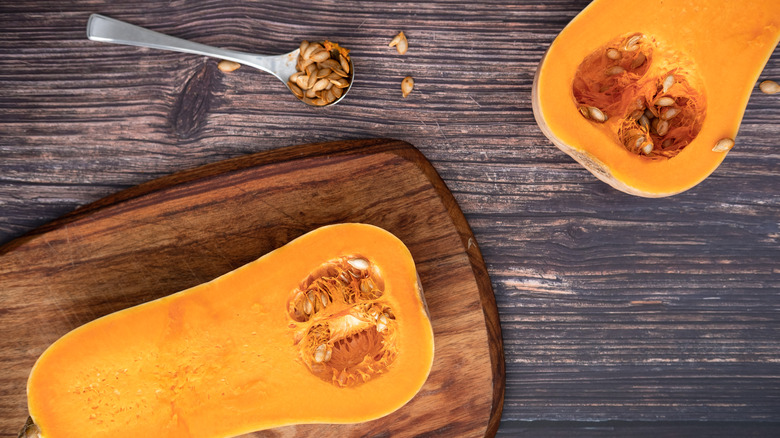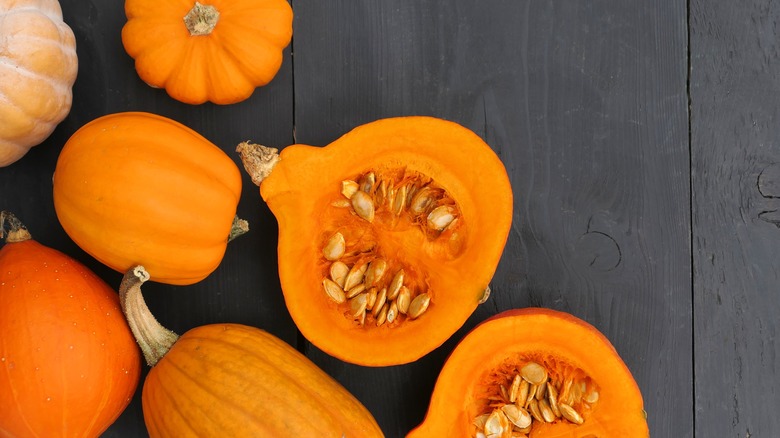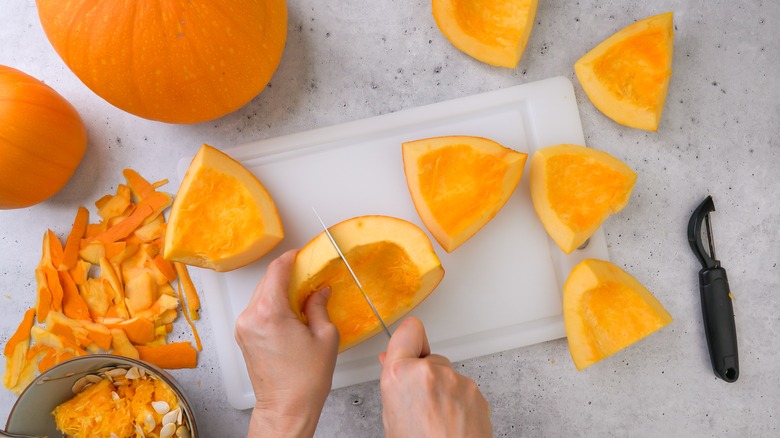The Microwave Trick That Makes Cutting Squash Less Scary
Even people who love to be in the kitchen have certain cooking tasks they dread, whether it's doing all the dishes after whipping up a multi-course meal or deveining pounds of shrimp for a dinner party. Sometimes, even the simplest tasks can seem like huge hassle, and at least when it comes to cutting winter squash, it turns out that dreading this activity is actually pretty sensible. That's because hard, slippery, roly-poly squash are pretty dangerous to cut. In fact, one survey by Just Eat, reported on by ABC, found that pumpkin and butternut squash are, respectively, the first and third most dangerous vegetables to prepare.
Luckily, there's one common household device that can make the process of cutting and peeling squash of all kinds a lot easier: the microwave. It's especially helpful for softening varieties of squash with hard, thick skins, like butternut and kabocha, which can be difficult to get your knife through. Basically, you can use the microwave to par-cook your whole squash until it's soft enough to cut all the way through. But there are a few important details you won't want to skip to make sure the process doesn't result in a different kind of disaster (we can only imagine what would happen if a whole squash were to explode in a microwave).
Preparing winter squash for the microwave
You can use a microwave to soften squash to make peeling and cutting it easier, but there's a right way to do it. The first thing you'll want to do is use a fork to poke several holes all over the squash. This is also advised when microwaving potatoes, as it lets the steam dissipate, rather than building up inside and leading to a messy explosion, which can also happen with squash (and frozen foods covered with plastic film, for that matter).
The next step is optional, but you can also score the squash all around the circumference, about ¼ inch deep, using a sharp paring or chef's knife. This will act as a guide for your knife when the squash comes out of the microwave. Just be really careful — when poking holes into and scoring the squash, it can be helpful to put the squash on a bunched-up dishtowel that's placed on a cutting board to help stabilize the squash and keep it from rolling around. Never hold the squash in your hands while poking it or scoring it. After all, the whole reason you're microwaving the squash is to make it easier to cut, so you don't want to risk getting injured in the process. Once your squash has been poked and scored, you're ready for the final step: microwaving it.
How to microwave squash to make it easier to cut
Once your winter squash is prepared, you can set it in a microwave-safe dish and add it to your microwave. Microwave smaller squash for about three minutes, large squash for about five. Test the squash with a paring knife to see if the skin can be easily penetrated; if it's still too hard to cut into easily, microwave the squash in additional 1 minute increments. Once it's softened up enough to cut, take it out of the microwave, letting it sit until it's cool enough to comfortably handle, then peel and chop. The good news is that microwaving doesn't just soften the hard squash flesh, but it also makes the squash easier to peel. In turn, peeling the squash will make it easier to cut into, meaning the whole squash situation becomes a lot less dangerous and less fussy after a quick ride in the microwave.
Using the microwave may just be the best way to peel and cut butternut squash and other tough-skinned winter squash varieties. You'll be able to focus less on how to avoid your knife slipping on a hard vegetable and chopping off a finger, and more on the tasty recipes you'll be making with your safely chopped butternut, kabocha, and kuri squash.


